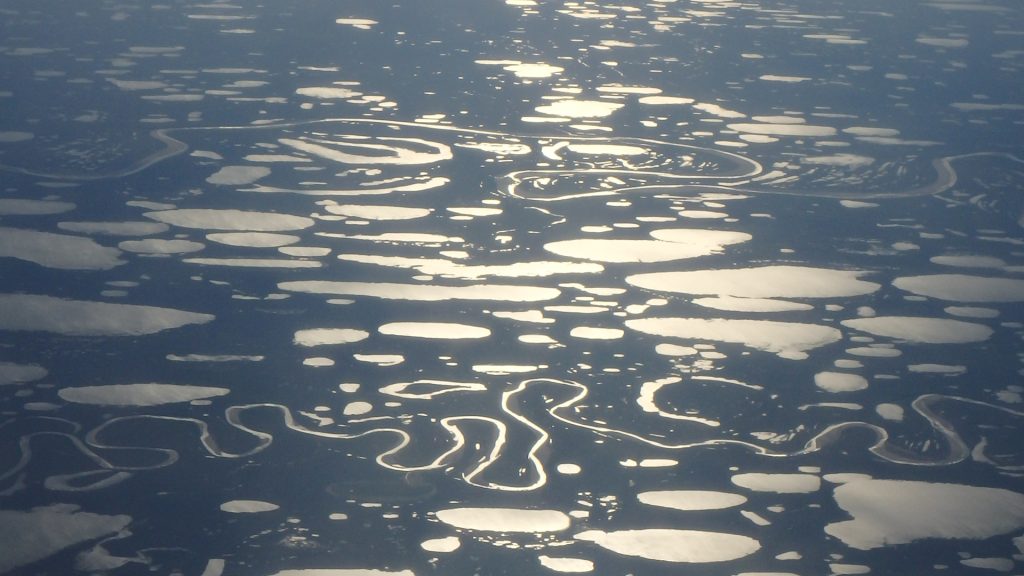Permafrost thawing, but role of microbes a big unknown
More research in the unknown role of microbes in thaw lakes is urgently needed, a new review paper by NESSC-scientists underlines. Permafrost areas across the globe are slowly thawing as the Earth warms up. As a result, more and more thaw lakes are emerging. Microbial life within these thaw lakes produces greenhouse gases. This development could therefore, in potential, accelerate further global warming. However, due to the lack of knowledge about these microorganisms it remains difficult to make predictions for the future. More research into microorganisms in thaw lakes is therefore urgently needed, the scientists write in a review article published in Trends in Microbiology.
Permafrost is an underground layer covering a quarter of the Earth’s surface in the Northern Hemisphere. It contains high levels of frozen organic material. As the Earth warms up, this layer is slowly thawing, causing a release of the organic material trapped within. Thaw lakes emerge as a result, and they are currently increasing in number and size. “Enormous meadow-like expanses start to appear, with in them lots of small lakes clustered together. These vast areas can be found in places like Northern Canada, for example,” explains Cornelia Welte, a researcher in the Ecological Microbiology department of the Radboud University.
Micro-organisms in the anoxic soils convert the organic material into methane, a greenhouse gas. It is very likely that thaw lakes therefore contribute to the enhanced greenhouse effect.

Measurement problems
Lots of research is being done around the world into how permafrost is changing, but it is still very difficult to predict how exactly thaw lakes are influencing climate change. Together with NESSC-researcher Michiel in ’t Zandt, Welte compiled all the available scientific knowledge of thaw lakes and noticed a substantial lack of data on microbial life in those lakes.
“Researchers often only take measurements in one lake and extrapolate those data to the whole area. That appears to not always be accurate. Each thaw lake is unique, and the micro-organisms within each lake are different,” says In ’t Zandt.
These regions are often inhospitable in the winter, which does not aid the research. “It’s difficult to take measurements in these regions during winter. What we’ve seen is that methane is produced during winter and is stored in the ice of the frozen lake. In spring, when the ice melts, there’s a huge release of methane. But it’s difficult to say exactly how much methane is released,” says Welte.
Quick test
Measurements therefore need to be taken in more locations, and more regularly, according to the researchers. But that is easier said than done. “At present, we have a lot of complicated tests that take a long time. The microbiological research we currently do isn’t something we could apply to every lake. So we need a faster, easier test to enable us to collect a lot of data more quickly.”
But in order to develop that kind of rapid test, the researchers first need to understand precisely which factors play a role in the production of greenhouse gases in these lakes. “We have seen that various methane-consuming microorganisms also convert a large proportion of the methane into the less harmful greenhouse gas carbon dioxide. But we really don’t know very much about these methane-eating bacteria, even though we know they play a role in the thaw lakes,” says Welte.
Thaw lakes in a bottle
That is why Radboud University microbiologists are now focusing on this research. “We’ve already been able to use soil samples from two thaw lakes in Alaska, brought back by fellow NESSC-researchers at VU Amsterdam,” says in ’t Zandt. “We bottled a small amount of these thaw lakes and looked at the influence of temperature on methane production by the microorganisms present. After carrying out this experiment for almost a year, one of the things we could see was that methane production does accelerate at higher temperatures. But more research into other factors is definitely needed, such as the influence of seawater on the microbial system in thaw lakes.”
Article:
Roles of thermokarst lakes in a warming world
Trends in Microbiology, 2020
in ‘t Zandt, M., Liebner, S. and Welte, C. U.
This research is part of the Gravitation-funded programmes Netherlands Earth System Science Center (NESSC) and Soehngen Institute for Anaerobic Microbiology (SIAM)

